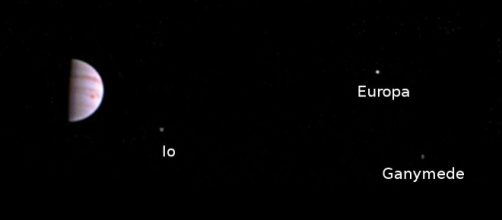After having been captured by the gravitational force of Jupiter on July 4, 2016, the spacecraft was inserted into an orbit around the gas giant that will allow it to study it in detail. This mission is expected to expand the understanding about Jupiter´s interior and its magnetic and gravitational fields. Juno´s visible camera was turned on six days after entering orbit around Jupiter and the first image of the gas giant was taken soon after, capturing the Jupiter´s system for the first time. More high resolution images of Jupiter´s poles are expected when Juno completes its first 53.5 days orbit.
Juno´s first flight through Jupiter´s radiation belts
After having travelled for around 4 years and eleven months, Juno arrived at Jupiter and was locked into an orbit around the biggest gas planet in the solar system. This orbit is intended to protect Juno´s instruments from very intense belts of radiation thousands of times stronger than the earth Van Allen Belts. After the first image sent, Juno proved that it passed safely this region of strong radiation, which the spacecraft will have to face on every single orbit around the gas giant.
Image taken from a distance
The first photo of the Jupiter´s system was taken on July 10, when Juno had travelled a distance and was at approximately 4.3 million km (2.7 million miles) from the gas giant on its first of two 53.5 days orbit around the giant planet.
This first image portrays one vertical half of Jupiter, showing its Great Red Spot and other light dark gas bands. To its left, Jupiter´s largest moons-from left to right-Io, Ganymede and Europa, are appreciated.
The camera installed on the spacecraft-Junocam, will continue taking photos on its 53.5 journey around the planet; however, the first high resolution images of Jupiter will be taken on August 27, when the spacecraft reaches its first close approach to the planet. During this brief time, Junocam will be able to take pics of Jupiter´s surface features.
Junocam
This is a color, visible light camera, consisting of four filters; red, green, blue and infrared. The red, green and blue strips are obtained during the first rotation of the spacecraft.
Juno´s rotation rate is two revolutions per minute. The infrared strip is obtained during the second rotation. When the two strips are combined into one, the final shot is obtained in great detail.
Mission
Juno will fly around Jupiter for 37 times. During its approach to the planet, the spacecraft will fly above its top gas clouds, at approximately 4,000 km (2,500 miles). During this flybys, Juno will study Jupiter´s atmosphere, Auroras and magnetosphere, expanding scientist’s knowledge and opening new horizons for future explorations of Jupiterand the advancement ofspace science.

